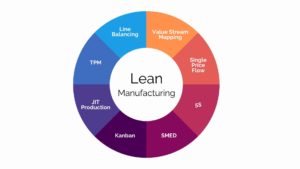When people hear about “lean manufacturing”, they often attribute this to things like assembly lines and other various tasks in a business. It may surprise people to learn though that these same principles can also be applied to engineering. While the lean logistics principles remain the same, there are a few key differences.
Some businesses have applied the lean manufacturing principles to engineering by also looking at the interconnected nature of the various steps in a workflow. The initial problem in engineering was due to the numerous iterations that engineering has, specifically when developing products.
Fortunately, this problem has largely been solved. For those who work in engineering, this article is right up your alley as we talk about how you can apply lean manufacturing principles to engineering.
Less Waste, More Value
Importance of Lean Manufacturing to Engineering
Studies have shown that 80% of a product’s cost is determined when the design of the product is being engineered. The factors that contribute to the product’s cost at this phase include:
- The number of parts to be used in a product
- The assembly techniques to be used as well as the processes in play
- The materials used
- The software used
- How complex the design is
- And whether or not the design can be reused
Thus, this phase is very critical in keeping costs low and bringing value to an all time high. This is one benefit that lean manufacturing brings to engineering.
Apart from that, the benefits also carry over from manufacturing. It improves efficiency by looking at the various processes and taking out the waste.
Waste in Engineering

One very important tenet of lean manufacturing is the elimination of waste at the workplace. Waste is described as something that does not add value to the customer.
In manufacturing, it is easy to see the waste as the product moves along the steps in a process. This is because most of these wastes are physical and can be seen. These include things like roadblocks, bottlenecks, and equipment breaking down just to name a few.
In engineering though, while the general concept remains largely the same, it has some differences.
For manufacturing, the goal is already defined. Many automated manufacturing plants have a fixed goal that are constantly being reached with every created product. For engineering, there are eight types of waste. These include:
- Over-production – This can also be rephrased as overanalysis. It is when additional and unneeded analysis, testing, and reporting are done.
- Inventory – This does not pertain to the inventory of items or materials on hand. Instead, this refers to needed analysis, testing, and reporting that have gone unfinished.
- Transportation – This waste is when there are handoffs of materials or tasks. In addition, it is when one step requires complex validation before moving along the process.
- Unnecessary Movement – If a person has too many projects or tasks on hand, chances are they’ll be jumping from one task to another. This is called the “stop and go” phenomenon and is considered inefficient and full of waste.
- Waiting – If an engineer has some time where they are just waiting for decisions or input in their work, this waiting time is also considered waste.
- Defective Outputs – If the product is defective, this means it has to go back to engineering in order for it to be fixed. The time it takes to be fixed is time that could have further been used to add more value to the customers.
- Over-processing – One good piece of advice is to keep things simple. Oftentimes, some people come up with complex forms of analysis or communications that only serve to muddle the process and waste time. For most cases, it is best not to reinvent the wheel, but to go for simple solutions.
- Foregoing Improvements – There is a lot of missed opportunity when the creativity of the engineers is not tapped to improve the engineering process.
The Five Key Principles
One of the most important lean concepts to learn is the five key principles. This set of steps guides the whole lean process, whether in manufacturing or engineering.
The first key principle is Value. This is always defined by the customer’s needs or wants for a specific product. In understanding what the customers want, the engineering team can then focus on it to make a better product that is of value to the customer.
The second is Understanding the Steps in the Process Chain. In pursuing lean, it is important to see and understand all the steps in the lifecycle of a product.
The third is Improving the Process Flow. After understanding the steps in the process chain, it will be easier to zone in on each step and improve the process. Separating the lifecycle into various steps also helps to monitor the improvements.

Fourth, we have the Customer’s Pull. Just like gravity pulls people down to Earth, a business is also attracted to the customer’s pull. This simply means that any product that is made should adhere to the needs of the customer.
Rather than creating a product that the business hopes customers will find useful, instead zone in on the need of a customer and create that product.
The final key principle we have is the Reach for Perfection. While perfection is not achievable, the effort to aim and reach for perfection is a worthwhile endeavor. It acts like a compass that guides the actions of the business to constant improvement. This then translates to a constant increase of value for the customers.
These five key principles are a cycle that constantly iterates as it improves the business overall.
Continuous Improvement
Identifying waste, reducing waste, improving value, and following the key principles is a constant cycle. Just because some of these have been applied doesn’t mean that the business should rest on their laurels.
They should continue to monitor their lean efforts and find ways to constantly improve.
In much the same way, the learning process for lean is also a continuous process. There are various lean training materials out there that can prove pivotal to the understanding and application of the lean manufacturing principles to engineering.
The path towards lean engineering will be worth it as you continue to reduce waste, improve your process, and push your business towards success.
You might also wanna check Establishing Lean Factory That Works: Top Tips to Consider.



